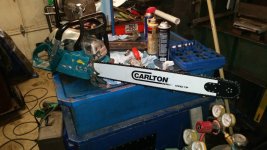If you use a progressive depth gauge tool to set the height of your depth gauges (a.k.a. "rakers"), there is far less need to keep all of your cutter lengths the same. These set the depth gauge height specifically for the tooth that follows them, which is as it should be. Both are used as shown in the second photo: they rest on top of one cutter, with the depth gauge poking up through the hole, and rest against the base of the cutter in front. The depth gauge is set by reference to the cutter associated with it, controlling the chip size for that cutter. They will set the correct height for that cutter regardless of the height of any other cutter.
View attachment 657178 View attachment 657179
The non-progessive types of depth gauges rest across two cutters to establish a depth gauge height. Since the cutters top plate slopes downward as you move to the back of the cutter, the height of the cutter changes depending on the cutter length. When cutters are two different lengths, you get two different heights, and the depth gauge will not be filed to the correct height for the cutter which follows it. One random cutter being off might not have much of an effect. The problem gets bigger when all of the cutters one on side are sharpened to a different length than the other. This often happens for several reasons: 1) a cheap or mis-adjusted grinder sharpens one side differently than the other, 2) a person hand-filing sharpens more aggressively with their dominant hand on one side, than with their other hand on the other side. If they are following the often-recommended idea of "counting strokes" to keep cutters the same, they slowly work the cutters on one side out of sync with the other, 3) If you hit a rock or dirt, you usually damage the cutters on one side more than the other. Sharpening until you remove the damage would leave the cutters on one side longer than the other. In this case,using the non-progressive gauge bridging across two cutters will set all of the depth gauges for left hand cutters at a different height in relation to that cutter than those for right hand cutter. Since the teeth on one side are taking a bigger bite than the ones on the other, this results in a chain that wants to cut on a curve. It also causes uneven wear on the bar rails, which increases the tendency to cut on a curve. The only way to avoid this when using a non-progressive depth gauge tool is to keep all cutters the same length.
Non-progressive depth gauge tools:
View attachment 657182

